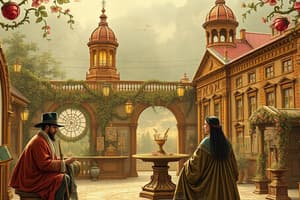Podcast
Questions and Answers
Who was the 22nd and 24th president of the United States?
Who was the 22nd and 24th president of the United States?
- James A. Garfield
- Benjamin Harrison
- Grover Cleveland (correct)
- Ulysses S. Grant
Who was the primary Union general during the American Civil War?
Who was the primary Union general during the American Civil War?
Ulysses S. Grant
Who lost to Ulysses S. Grant in the election of 1868?
Who lost to Ulysses S. Grant in the election of 1868?
Horatio Seymour
Who was known as a financier that caused a financial panic in 1869?
Who was known as a financier that caused a financial panic in 1869?
What title is given to Thomas Nast for his political cartoons?
What title is given to Thomas Nast for his political cartoons?
Which president was involved in the Hayes-Tilden election, known for corruption?
Which president was involved in the Hayes-Tilden election, known for corruption?
Who was the 20th president of the United States?
Who was the 20th president of the United States?
Who passed the Pendleton Act, transferring jobs from patronage to merit?
Who passed the Pendleton Act, transferring jobs from patronage to merit?
What was the significance of the term 'Gilded Age'?
What was the significance of the term 'Gilded Age'?
What does the term 'pork-barrel bills' refer to?
What does the term 'pork-barrel bills' refer to?
What political doctrine supports the rights and powers of the common people?
What political doctrine supports the rights and powers of the common people?
The ___ system involved promoting civil servants who are friends of those in power.
The ___ system involved promoting civil servants who are friends of those in power.
What was the 'crime of '73'?
What was the 'crime of '73'?
Who were the Liberal Republicans?
Who were the Liberal Republicans?
What did the Compromise of 1877 result in?
What did the Compromise of 1877 result in?
Who was the 'King of Banking' during this period?
Who was the 'King of Banking' during this period?
What was the purpose of the Bland-Allison Act?
What was the purpose of the Bland-Allison Act?
Flashcards are hidden until you start studying
Study Notes
Key Figures in American Politics
- Grover Cleveland: Served as both 22nd and 24th president, known for honesty and anti-corruption efforts, vetoed excessive bills, and promoted civil service reform.
- Ulysses S. Grant: 18th president and notable Union general in the Civil War, presidency marked by corruption scandals.
- Horatio Seymour: Democratic candidate who lost to Grant in the 1868 presidential election.
- Jay Gould: Influential financier involved in the Erie Canal and responsible for the 1869 financial panic through gold market manipulation.
- Thomas Nast: Renowned cartoonist who created "Uncle Sam," contributed to political satire, and helped expose corruption in Tammany Hall.
Elections and Presidential Terms
- Rutherford B. Hayes: 19th president involved in the controversial Hayes-Tilden election, considered one of the most corrupt elections in U.S. history.
- Samuel Tilden: Democratic nominee who narrowly lost the 1876 presidential election to Hayes.
- James A. Garfield: 20th president, assassinated shortly after taking office.
- Chester A. Arthur: Succeeded Garfield, shifted from Stalwart to Half-Breed, and enacted the Pendleton Act.
Political and Economic Issues
- Benjamin Harrison: 23rd president, criticized for poor leadership, introduced the McKinley Tariff, and increased federal spending significantly.
- William McKinley: 25th president, engaged in the Spanish-American and Philippine-American Wars, promoted American imperialism.
- J.P. Morgan: Dominant figure in banking and finance, known for his control over railroads and significant influence on the U.S. Treasury.
Social and Economic Context
- Gilded Age: An era characterized by the contrast of surface prosperity masked by widespread corruption, poverty, and wealth inequality.
- Spoils System: System of awarding government jobs to political supporters rather than based on merit.
- Crop-Lien System: Allowed farmers to secure credit against future crop yields, often leading to cycles of debt.
Political Concepts and Legislation
- Populism: Advocated for the rights of the common people against powerful elites.
- Grandfather Clause: Allowed individuals to bypass certain laws based on prior circumstances.
- Ohio Idea: Proposed redemption of greenbacks instead of gold to alleviate debt burdens for poorer Western delegates.
Corruption and Scandals
- Tweed Ring: A corrupt faction within Tammany Hall in NYC, exposed by reformers like Tilden.
- Credit Mobilier: Scandal involving a construction company awarded contracts for building the Union Pacific Railroad, with allegations of bribery involving government officials.
- Whiskey Ring: Scandal where government officials defrauded the treasury by evading taxes on imported whiskey.
Economic Policies and Legislation
- Liberal Republicans: Emerged in 1872, advocating an end to Reconstruction efforts.
- "Crime of '73": Refers to the Fourth Coinage Act which established the gold standard and demonetized silver, negatively impacting miners.
- Bland-Allison Act: Mandated government purchase of silver for coinage.
- Greenback Labor Party: A political party formed from farmers seeking inflationary policies and labor improvements.
Military and Political Organizations
- Grand Army of the Republic: An organization of Civil War Union veterans that became a significant political force for the Republican Party.
- Stalwart and Half-Breed: Distinctions within the Republican Party regarding loyalty to the patronage system and civil service reform.
End of Reconstruction
- Compromise of 1877: Agreement that ended Reconstruction by removing troops from the South, appointing a Democrat to the cabinet, and providing federal funds for infrastructure projects.
- Pendleton Act: Act that reformed the federal job system by shifting from a patronage-based system to one based on merit.
Studying That Suits You
Use AI to generate personalized quizzes and flashcards to suit your learning preferences.




